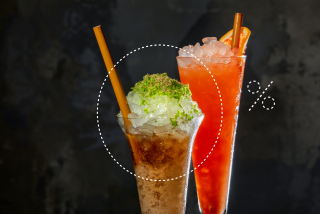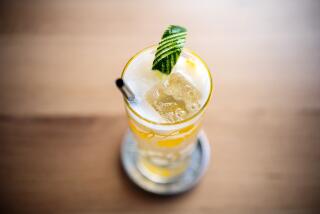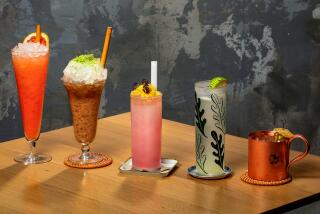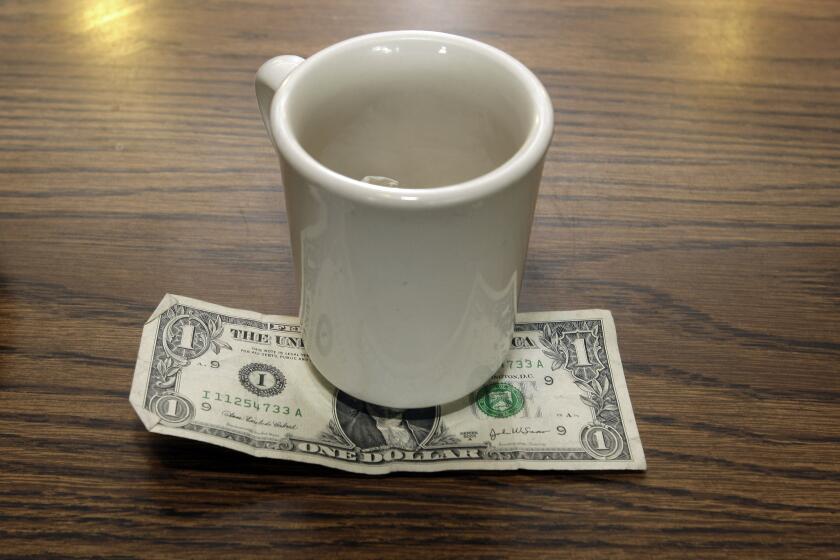A Smooth Mix That Goes Down Easy
- Share via
A quote from a mob boss and murderer who did hard time in Alcatraz before dying of syphilis might not seem the ideal blessing for a new book.
But in context, none better than Al Capone to speak to “Classic Cocktails of the Prohibition Era” by Philip Collins (General Publishing Group), a slick, sophisticated Baedeker of highballs blended when the ‘20s were roaring to jazz, raids on gin joints, machine gun rub-outs, and voices for and against the 18th Amendment.
As Scarface once complained in person, and now in posthumous introduction: “When I sell liquor, it’s bootlegging. When my patrons serve it on Lakeshore Drive, it’s hospitality.”
Author and therapeutic tippler Collins--now of Los Angeles, and an 18-year expatriate Englishman fascinated by cultural fragments of America’s past--collected 100 recipes for his glossy cocktail table book.
But don’t look in this little encyclopedia for the expected and mundane, your Old Fashioneds, Sidecars, Martinis, Stingers and Sloe Gin Fizzes. They were not of the era. Besides, a world-class martini is made from virtually undiluted liquor and that requires palatable, certainly survivable gin to begin with. Capone and associates delivered only bathtub gin and whiskey that doubled as oven cleaner. So drinks were mixed with fresh lemon, orange and lime juices, grenadine, absinthe and bitters to file the jagged edges off unrefined booze.
Prohibition cocktails--those Lakeshore Drive cocktails that were somewhat more urbane than gin mill hooch--evolved as Uptown Exotica with names reflecting raucous histories. Of the people: The Gene Tunney Cocktail. The Charlie Chaplin. Mary Pickford and Vanderbilt cocktails. Of the places: Palm Beach Cocktail. Kentucky Blizzard. Jockey Club and Cafe de Paris cocktails. Of the ladies: Pink Lady. Shady Lady. Widow’s Kiss and Maiden’s Prayer.
For literary accuracy, naturally, all recipes were test-mixed by Steve Zell of San Francisco’s Cypress Club and taste-tested by Collins before publication alongside quotes from celebrities who respected cocktails as a social accommodation, not a shortcut to getting legless.
Miguel de Cervantes: “I drink when I have occasion, and sometimes when I have no occasion.”
John Ciardi: “There is nothing wrong with sobriety in moderation.”
W.C. Fields, of course: “I exercise self-control. I never drink anything stronger than gin before breakfast.”
Elevating the book above just another bar guide is the superb quality of its paper, printing and design complementing exquisite photography by Sam Sargent, whose every shot is in absolute character and perfectly positioned in time.
The Silver Bullet (kummel, gin and lemon juice) is pearl-clouded crystal poured into an Orrefors Nobel martini glass. With the partial, blued, almost sensual shape of a Thompson submachine gun in the background. The Clover Club (grenadine, egg white and gin) is ruby rich within a Cristal de Sevres Mila tumbler. It is alongside an Art Deco Ronson table lighter in the form of a cocktail bar with a stereotypical Cotton Club bartender that probably will not delight the NAACP.
In an interview, author Collins--who also has written a book on old radios and plans to follow it with another on vintage television sets--says the “massive irony of Prohibition was that so many of our best drinks came from this age of forbidden fruits.
“My favorite from the book is the Silver Bullet,” he says. “But my favorite tipple, I’m afraid, is a Greyhound.”
That’s with modern vodka from these Narcissistic Nineties.
More to Read
Eat your way across L.A.
Get our weekly Tasting Notes newsletter for reviews, news and more.
You may occasionally receive promotional content from the Los Angeles Times.










